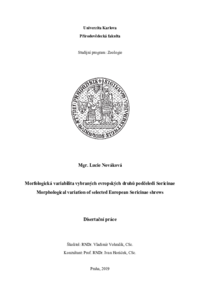Morfologická variabilita vybraných evropských druhů podčeledi Soricinae
Morphological variation of selected European Soricinae shrews
rigorózní práce (UZNÁNO)

Zobrazit/
Trvalý odkaz
http://hdl.handle.net/20.500.11956/122481Identifikátory
SIS: 226768
Katalog UK: 990023866620106986
Kolekce
- Kvalifikační práce [21484]
Autor
Fakulta / součást
Přírodovědecká fakulta
Obor
Zoologie
Katedra / ústav / klinika
Katedra zoologie
Datum obhajoby
30. 9. 2020
Nakladatel
Univerzita Karlova, Přírodovědecká fakultaJazyk
Čeština
Známka
Uznáno
Rejskové podčeledi Soricinae tvoří jedny z nejpočetnějších a nejběžnějších zástupců savčí fauny Holarktické oblasti. Jejich uniformní fenotyp a skrytý způsob života však znesnadňuje jejich výzkum. V důsledku toho zákonitosti, které ovlivňují jejich fenotyp a geografickou variabilitu, zůstávají z velké míry neobjasněny. V této disertační práci jsem se proto zaměřila na vybrané aspekty morfologické variability tří zástupců této podčeledi. V první části disertační práce jsme otestovali vliv pohlaví a věku na morfologickou variabilitu krania rejska obecného (Sorex araneus) v rámci jedné populace. Odhalili jsme sexuální dimorfismus u rejsků a také rozdíly mezi věkovými skupinami. Na základě této studie byly vybrány vhodné kraniální proměnné pro navazující studie. V druhé části projektu jsme se zaměřili na geografickou variabilitu rejska obecného (Sorex araneus) v Evropě v prostoru mezi Baltickým a Jaderským mořem. Zjistili jsme vliv zeměpisné šířky i délky a také nadmořské výšky na velikost rejsků. Ta také výrazně korelovala s vybranými klimatickými proměnnými. Třetí část disertačního projektu byla věnována popisu Dehnelova fenoménu a zjištění případného geografického trendu v jeho průběhu. Zjistili jsme, že zmenšení a následné opětovné dorůstání mozkovny je korelováno s rozdílnými klimatickými faktory...
Soricinae shrews are one of the most common and abundant mammalian group in Holarctic Region. The uniform phenotype and hidden way of life make the research on this group challenging. Basic rules that drive their phenotype and morphological variation still remain unclear. The aim of this dissertation is to clarify the selected aspects of morphological variation in three European Soricinae species. The first part of this thesis is aimed on age and sex skull variation in a single population of the common shrew (Sorex araneus). We found significant sexual dimorphism and differences between age groups. Based on this study we selected cranial variables suitable for following studies. The second part of the dissertation project was aimed on geographic variation of the common shrew in the area between the Baltic and the Adriatic sea. We found correlation between size of shrews and latitude, longitude as well as altitude. Size was also correlated with selected climatic variables. The third part of the project was focused on a description of Dehnel's phenomenon and its geographic pattern. We found that decrease and regrowth of the braincase is separately correlated with different climatic variables. Our results suggest that different evolutionary processes and pressures are involved with two phases of...
